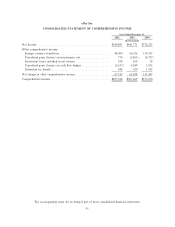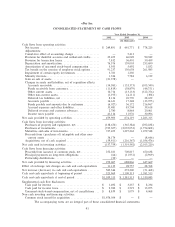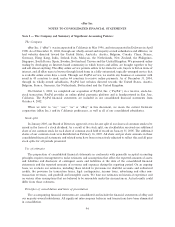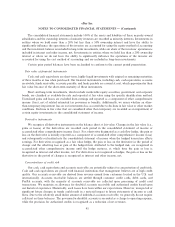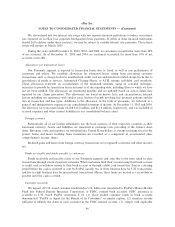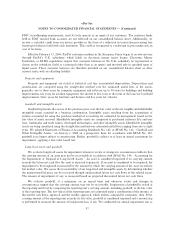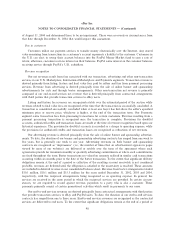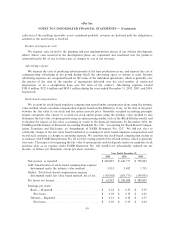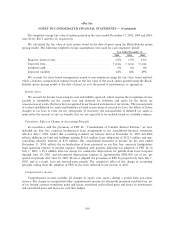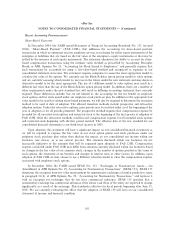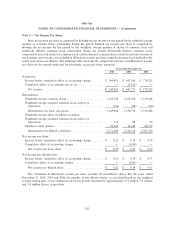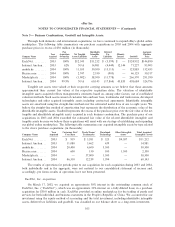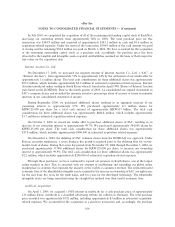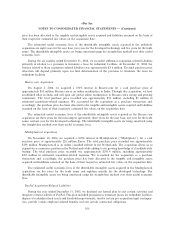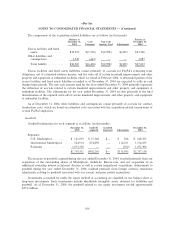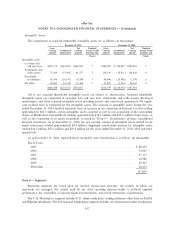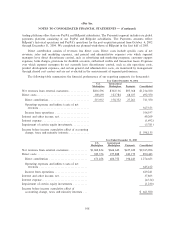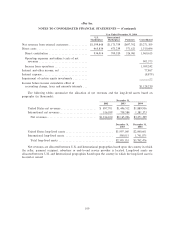eBay 2004 Annual Report Download - page 103
Download and view the complete annual report
Please find page 103 of the 2004 eBay annual report below. You can navigate through the pages in the report by either clicking on the pages listed below, or by using the keyword search tool below to find specific information within the annual report.eBay Inc.
NOTES TO CONSOLIDATED FINANCIAL STATEMENTS Ì (Continued)
Recent Accounting Pronouncements
Share-Based Payments
In December 2004, the FASB issued Statement of Financial Accounting Standards No. 123 (revised
2004), ""Share-Based Payment'' (FAS 123R), that addresses the accounting for share-based payment
transactions in which an enterprise receives employee services in exchange for either equity instruments of the
enterprise or liabilities that are based on the fair value of the enterprise's equity instruments or that may be
settled by the issuance of such equity instruments. The statement eliminates the ability to account for share-
based compensation transactions using the intrinsic value method as prescribed by Accounting Principles
Board, or APB, Opinion No. 25, ""Accounting for Stock Issued to Employees,'' and generally requires that
such transactions be accounted for using a fair-value-based method and recognized as expenses in our
consolidated statement of income. The statement requires companies to assess the most appropriate model to
calculate the value of the options. We currently use the Black-Scholes option pricing model to value options
and are currently assessing which model we may use in the future under the new statement and may deem an
alternative model to be the most appropriate. The use of a diÅerent model to value options may result in a
diÅerent fair value than the use of the Black-Scholes option pricing model. In addition, there are a number of
other requirements under the new standard that will result in diÅering accounting treatment than currently
required. These diÅerences include, but are not limited to, the accounting for the tax beneÑt on employee
stock options and for stock issued under our employee stock purchase plan. In addition to the appropriate fair
value model to be used for valuing share-based payments, we will also be required to determine the transition
method to be used at date of adoption. The allowed transition methods include prospective and retroactive
adoption options. Under the retroactive options, prior periods may be restated either as of the beginning of the
year of adoption or for all periods presented. The prospective method requires that compensation expense be
recorded for all unvested stock options and restricted stock at the beginning of the Ñrst quarter of adoption of
FAS 123R, while the retroactive methods would record compensation expense for all unvested stock options
and restricted stock beginning with the Ñrst period restated. The eÅective date of the new standard for our
consolidated Ñnancial statements is our third Ñscal quarter in 2005.
Upon adoption, this statement will have a signiÑcant impact on our consolidated Ñnancial statements as
we will be required to expense the fair value of our stock option grants and stock purchases under our
employee stock purchase plan rather than disclose the impact on our consolidated net income within our
footnotes (see above), as is our current practice. The amounts disclosed within our footnotes are not
necessarily indicative of the amounts that will be expensed upon adoption of FAS 123R. Compensation
expense calculated under FAS 123R may diÅer from amounts currently disclosed within our footnotes based
on changes in the fair value of our common stock, changes in the number of options granted or the terms of
such options, the treatment of tax beneÑts and changes in interest rates or other factors. In addition, upon
adoption of FAS 123R we may choose to use a diÅerent valuation model to value the compensation expense
associated with employee stock options.
In December 2004, the FASB issued SFAS No. 153, ""Exchanges of Nonmonetary Assets Ì An
Amendment of APB Opinion No. 29, Accounting for Nonmonetary Transactions'' (SFAS 153). SFAS 153
eliminates the exception from fair value measurement for nonmonetary exchanges of similar productive assets
in paragraph 21(b) of APB Opinion No. 29, ""Accounting for Nonmonetary Transactions,'' and replaces it
with an exception for exchanges that do not have commercial substance. SFAS 153 speciÑes that a
nonmonetary exchange has commercial substance if the future cash Öows of the entity are expected to change
signiÑcantly as a result of the exchange. This standard is eÅective for Ñscal periods beginning after June 15,
2005. We are currently evaluating the eÅect that the adoption of SFAS 153 will have on our consolidated
statement of income and Ñnancial condition.
101


